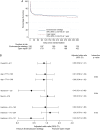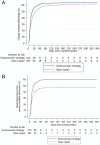Endovascular strategy or open repair for ruptured abdominal aortic aneurysm: one-year outcomes from the IMPROVE randomized trial
- PMID: 25855369
- PMCID: PMC4553715
- DOI: 10.1093/eurheartj/ehv125
Endovascular strategy or open repair for ruptured abdominal aortic aneurysm: one-year outcomes from the IMPROVE randomized trial
Abstract
Aims: To report the longer term outcomes following either a strategy of endovascular repair first or open repair of ruptured abdominal aortic aneurysm, which are necessary for both patient and clinical decision-making.
Methods and results: This pragmatic multicentre (29 UK and 1 Canada) trial randomized 613 patients with a clinical diagnosis of ruptured aneurysm; 316 to an endovascular first strategy (if aortic morphology is suitable, open repair if not) and 297 to open repair. The principal 1-year outcome was mortality; secondary outcomes were re-interventions, hospital discharge, health-related quality-of-life (QoL) (EQ-5D), costs, Quality-Adjusted-Life-Years (QALYs), and cost-effectiveness [incremental net benefit (INB)]. At 1 year, all-cause mortality was 41.1% for the endovascular strategy group and 45.1% for the open repair group, odds ratio 0.85 [95% confidence interval (CI) 0.62, 1.17], P = 0.325, with similar re-intervention rates in each group. The endovascular strategy group and open repair groups had average total hospital stays of 17 and 26 days, respectively, P < 0.001. Patients surviving rupture had higher average EQ-5D utility scores in the endovascular strategy vs. open repair groups, mean differences 0.087 (95% CI 0.017, 0.158), 0.068 (95% CI -0.004, 0.140) at 3 and 12 months, respectively. There were indications that QALYs were higher and costs lower for the endovascular first strategy, combining to give an INB of £3877 (95% CI £253, £7408) or €4356 (95% CI €284, €8323).
Conclusion: An endovascular first strategy for management of ruptured aneurysms does not offer a survival benefit over 1 year but offers patients faster discharge with better QoL and is cost-effective.
Clinical trial registration: ISRCTN 48334791.
Keywords: Aneurysm; Aorta; Cost-effectiveness; Rupture; Stent grafts; Surgery.
© The Author 2015. Published by Oxford University Press on behalf of the European Society of Cardiology.
Figures





References
-
- Karthikesalingam A, Holt PJ, Vidal-Diez A, Ozdemir BA, Poloniecki JD, Hinchliffe RJ, Thompson MM. Mortality from ruptured abdominal aortic aneurysms: clinical lessons from a comparison of outcomes in England and the USA. Lancet 2014;383:963–969. - PubMed
-
- Mani K, Lees T, Beiles B, Jensen LP, Venermo M, Simo G, Palombo D, Troeng T, Wigger T, Bjorck M. Treatment of abdominal aortic aneurysm in nine countries 2005–2009: a Vascunet report. Eur J Vasc Endovasc Surg 2011;42:598–607. - PubMed
-
- Gupta PK, Ramanan B, Engelbert TL, Tefera G, Hoch JR, Kent KC. A comparison of open surgery versus endovascular repair of unstable ruptured abdominal aortic aneurysms. J Vasc Surg 2014;60:1439–1445. - PubMed
-
- Hinchliffe RJ, Bruijstens L, MacSweeney ST, Braithwaite BD. A randomised trial of endovascular and open surgery for ruptured abdominal aortic aneurysm - results of a pilot study and lessons learned for future studies. Eur J Vasc Endovasc Surg 2006;32:506–513. - PubMed
Grants and funding
LinkOut - more resources
Full Text Sources
Other Literature Sources
Medical

